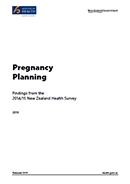
This report describes the degree to which women planned their most recent pregnancy, based on their answers to questions about contraceptive use, timing, intention, desire for a baby, partner discussion, and pre-conceptual preparations. Unplanned pregnancies can result in adverse health outcomes for pregnant women and their children.
The differences in degree of pregnancy planning are examined with regard to age, ethnicity, and neighbourhood deprivation, for women who were pregnant in the five years preceding the survey. The most recent pregnancy in the last five years could be current at the time of the survey, or have ended in a birth, miscarriage, stillbirth or abortion.
Use our Sexual and Reproductive Health Data Explorer to see the results from the 2014/15 Health Survey.
If you have any queries please email [email protected].
Overview of key findings
- One in three women aged 16–44 years had been pregnant in the last five years.
- Just over half of all women’s most recent pregnancies were planned (54%); nearly one-third were ambivalent (32%); and the remaining 14% were unplanned.
- Younger women were less likely to have been engaging in behaviours to prepare for pregnancy before their most recent pregnancy than older women. Māori women and Pacific women were less likely to have been engaging in behaviours to prepare for pregnancy before their most recent pregnancy, compared to non-Māori women, and non-Pacific women.
- Nearly half of women surveyed reported having taken folic acid tablets/supplements before their most recent pregnancy in the last five years; however, this occurred among only about one-fifth of those aged 16–24. Pacific and Māori women were less likely to report having taken folic acid tablets/supplements prior to their most recent pregnancy in the last five years than non-Pacific and non-Māori women.
- One-third of women reported having eaten more healthily prior to their most recent pregnancy; this was more commonly reported by older women. Women living in the most deprived neighbourhoods were less likely to report this than those living in the least deprived neighbourhoods.
Go to Sexual and reproductive health to find out what’s being done in this area.
Related publications
- Sexual and Reproductive Health Data Explorer
- First Heterosexual Sex: Findings from the 2014/15 New Zealand Health Survey
- Heterosexual Sexual Behaviour: Findings from the 2014/15 New Zealand Health Survey
- Sexual Orientation: Findings from the 2014/15 New Zealand Health Survey
- Contraception: Findings from the 2014/15 New Zealand Health Survey
- Sexually Transmitted Infections: Findings from the 2014/15 New Zealand Health Survey
- Non-volitional Sex: Findings from the 2014/15 New Zealand Health Survey
- Indicator Interpretation Guide 2014/15: Sexual and Reproductive Health Module
- Questionnaires and Content Guide 2014/15: New Zealand Health Survey
- Methodology Report 2014/15: New Zealand Health Survey
- The New Zealand Health Survey Sample Design, Years 1–3 (2011–2013)
